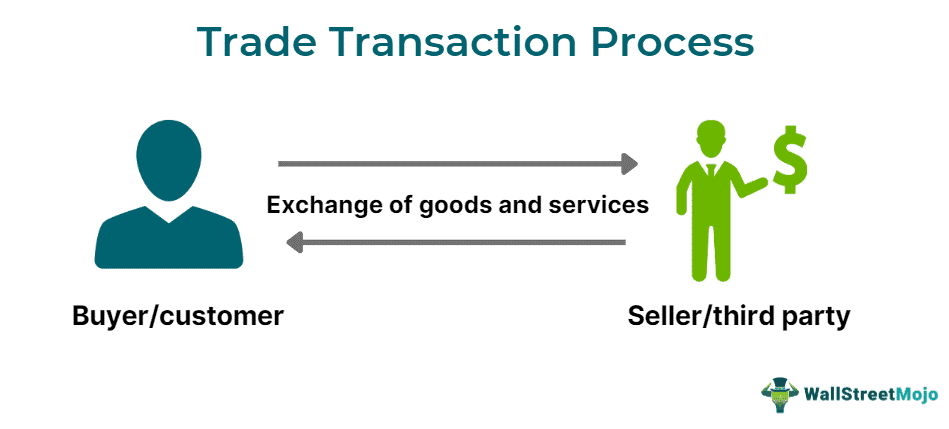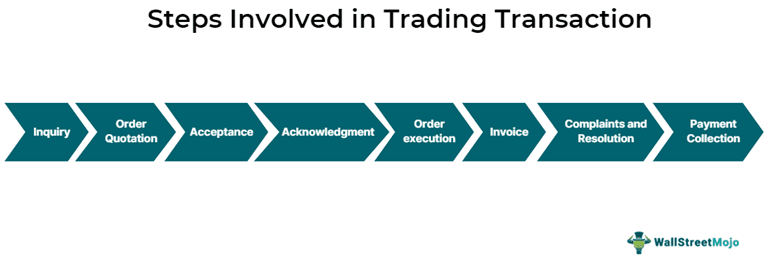Table of Contents
Trade Transaction Meaning
A trade transaction occurs when the customer sells or buys products or services from or to a third party. It includes any contract(s) on which the transaction is based. Trade transactions can take several forms, such as purchasing, selling, bartering, and trading.

Trading transactions occur when one party wants to buy, and another wants to sell, and both parties must complete a set of processes. They help businesses obtain resources, expand from their existing markets, and generate funds. The transactions stimulate economic growth, strengthen international trade relations, and benefit national development and prosperity.
Key Takeaways
- A trade transaction involves purchasing and selling goods or services between two parties, with price being the consideration.
- These transactions benefit national economies by stimulating growth, job creation, innovation, and market access.
- They also facilitate the exchange of capital, goods, and services among individuals, businesses, and nations and international trade relations.
- It starts with an inquiry, followed by a quotation, order, and invoice. The seller responds with details about the items, delivery time, pricing, and payment conditions.
- If the order takes longer, the seller must inform the buyer.
Trade Transaction Explained
A trade transaction is the activity of purchasing and selling between two parties, the buyer and the seller. Price is the consideration for which a trade transaction is carried out. Transactions benefit national economies by stimulating growth in the economy, job creation, innovation, and access to markets. They make it easier to interchange products, services, and capital, which boosts productivity, increases competitiveness, and generates revenue and tax money for governments.
These transactions are also vital in the international economy, facilitating the exchange of capital, goods, and services among individuals, businesses, and nations. They enable businesses to acquire resources, expand markets, and generate revenue, promoting economic growth, international trade relations, and national development.
The first step of a trade transaction is to define demands and negotiate factors such as price, quality, quantity, and delivery. The buyer submits an order, confirms their requirement with the transaction, and the seller approves it. Payment is an important step in the process. The buyer can make the agreed-upon payment via a variety of methods. The seller subsequently completes the transaction, which could include manufacturing, packaging, transporting, or providing services.
The buyer receives the goods or services either directly from the supplier or through intermediaries such as logistical companies. The buyer examines the received goods or services to confirm that they satisfy the agreed-upon requirements and quality standards. If the buyer is content, they accept the purchase, and the parties exchange the necessary papers.
Steps
The steps involved in a trading transaction are given as follows.

- Inquiry: A trading transaction begins with an inquiry, which is a request made by a prospective buyer to the desired seller about the items they are interested in purchasing. Buyers frequently query about quality, size, form, design, packaging, quantity, delivery time, pricing, payment conditions, credit period, offers, samples, cost lists, and catalogs. These queries may be either written or verbal.
- Order Quotation: A quotation is a seller's response to an inquiry and an offer to sell their goods to a buyer under certain terms and conditions. It must be submitted promptly, and all aspects of the inquiry must be addressed. The quotation shall include information about the quality and quantity of items, the sale price per unit, the discount, the delivery time, mode, location, payment conditions, tariffs, taxes, mode of transportation, and packing and labeling.
- Acceptance: An order is the buyer's acknowledgment of a quotation from multiple dealers. After evaluating numerous quotes, the buyer selects the most appropriate one for their needs. Once accepted, an order is placed with the dealer, which may be accepted orally or in writing. Typically, printed order forms are utilized, which include information such as quantity, quality, rate, total price, payment conditions, delivery time and location, mode of delivery, and necessary packing. In this stage, any vouching of trade transaction (guarantee of payment), if preferred, is also accepted.
- Acknowledgment: Following receipt of an order, the seller recognizes it and swiftly provides it to the customer. For new clients seeking credit, the supplier shall inquire about their creditworthiness using trade references, banker references, and published data. If the seller is content with the buyer's credibility, the order is processed; otherwise, the purchase is denied. However, if the order is from a repeat customer, a creditworthiness check may not be required, lowering the chance of bad debt.
- Order Execution: If a seller is not happy with a buyer's creditworthiness, they may refuse the order. However, if the seller is content with the customer's status, the order should be acknowledged as received. If the order takes longer than expected, the supplier should notify the buyer in writing. The order execution procedure entails notifying the warehouse keeper, packing and shipping the products, providing a delivery note, and organizing transportation.
- Invoice: An invoice is a document that includes information about the goods supplied to consumers as well as the total payment due. It is delivered by the seller typically immediately after the products are sent or with the goods, depending on the seller's policy. It is a printed invoice for products sold on credit that specifies the quality and amount of the goods.
- Complaints and Resolution: Buyers check items to orders after accepting delivery and report any differences. Complaints are often filed due to defective items, order execution delays, wrong packing, increased prices, calculation errors, excess or lesser amounts, or damage to goods shipped. These issues can be settled by calm conversations or by using credit or debit notes.
- Payment Collection: The final stage of a trading transaction is the receipt of money or sale proceeds. In cash sales, the products are collected immediately, whereas in credit sales, the vendor provides the customer with a statement of account, which can then be settled. If vouching of trade transactions is done and accepted, cash collection may be complex.
Examples
Let us use a few examples to understand the topic.
Example #1
Let us say Buyer A, a furniture manufacturer, and Buyer B, a timber supplier, engage in a trading transaction to exchange wood for furniture production. Buyer A orders wood, and Buyer B prepares it to meet specifications. The wood is delivered to Buyer A's facility, where it is used to create furniture. Once completed, the furniture is delivered to Buyer B, who inspects it to ensure it meets quality standards. If satisfied, Buyer B accepts cash in exchange for the wood. This trade transaction benefits both parties by providing payment for the wood.
Example #2
A publication of the World Trade Organisation (WTO) named "Trade Finance and SMEs- Bridging the gaps in provision" talks about trade finance. This concept plays a major role in mitigating the risks of "cashless trade transactions." The publication majorly talks about the shortage of funds or trade finance required for trading transactions in developing countries. It also mentions the efforts taken to support trade finance. One such significant mention was the African Development Bank (AfDB) launching a permanent program in 2013, financing nearly $1 billion in trading transactions in Africa that aimed to support over $10 billion over the next few years.
Digital Trade Transaction
Digital trade transactions refer to the electronic exchange of goods, services, or financial assets via digital platforms, online marketplaces, or e-commerce websites. These transactions use the Internet and computer networks to simplify trade activities, resulting in convenience, worldwide client reach, and potential revenue. Secure payment gateways for regular and e-trade transaction fees, digital signatures, encryption, and electronic documentation are some of the capabilities that digital platforms offer to help streamline the transaction process.
Examples of digital trade transactions include online purchases of physical things, digital downloads, software license agreements, services that are subscription-based, and online consulting or freelance work. Digital commerce transactions have altered traditional trade processes, making cross-border trading more accessible. Current times have made payments and the e-trade transaction fee easier and affordable; this has contributed to its expansion. As a result, they have fueled the expansion of e-commerce, enhanced global connectivity, and created new opportunities for economic involvement and prosperity.
